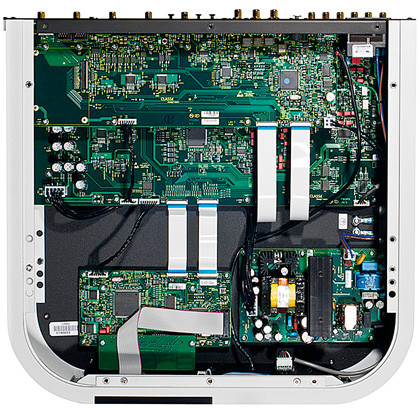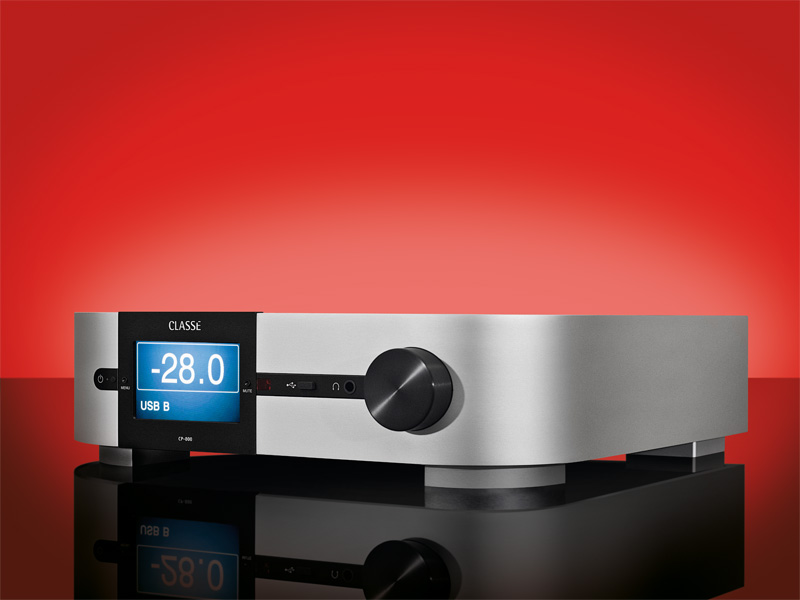TechRadar Verdict
Pros
- +
Excellent USB DAC
- +
Impressive range of features
- +
Good build quality
Cons
- -
Not as fast as a pure analogue preamp
Why you can trust TechRadar
Classé's new CP-800 preamp is less expensive, yet significantly more well featured than its predecessor the CP-700. In fact, it has more features than any dedicated two-channel preamp we have ever encountered!
For starters, it has digital, as well as analogue inputs and, of these, two are USB connections; one in the front panel for your Apple device and another on the back for a computer. Then it has five output channels with which to incorporate a second system or extra power amps and subwoofer(s) and that's only the connections.
Inside the sleek aluminium casework it's stacked with technological firepower, including bass management, so that you can optimise low-frequency performance almost regardless of where speakers are placed and parametric EQ.
If that weren't enough it also has something we've not seen on a high end preamp since the seventies; tone controls. All this with barely a button in sight thanks to a 16:9 touch screen.
Better than any CD?
The most controversial thing about the CP-800 however, is that Classé head of sales, Dave Nauber, claims that his iPhone sounds better through it than any CD transport. The front USB extracts a digital stream from your iDevice but that is fighting talk in our books.
When HFC met Alan Clark, the Scotsman who designed it (and the rest of the Classé range), he wasn't quite so bullish but did claim that the USB input could outperform the S/PDIF – which is pretty controversial itself. Alan has come up with a variation on the USB receiver, which he claims is superior to all the alternatives on the market.
He accepts that the asynchronous route chosen by increasing numbers of serious USB DAC-makers is better than the synchronous approach found in more affordable convertors, but has added a twist which is said to make the CP-800 a world-beater with this computer audio link.
Clark calls regular asynchronous USB interfaces 'non-optimal' because the ground noise that is inevitable with computer sources pollutes the clock and the DAC in the receiver. His solution to this has been to add an FPGA (field programmable gate array) between the USB microcontroller/receiver and the DAC, as a means of isolating both it and the audio clocks within the preamp.

The USB receiver has its own clock but it's impossible to fully isolate this because the noise levels are very high within the chip, The FPGA recovers only the data from the incoming signal and uses the precision clock within the CP-800 in order to minimise jitter.
The preamp also has an unusual power supply (PSU). One reason why it costs less than its predecessor is that the PSU is onboard rather than being in a separate box, but that's not the only difference. The CP-800 has a switched-mode PSU that operates at very high frequencies, which its claimed makes it less noisy than traditional linear supplies. It also makes it more efficient (as is usually the case) and this product hits the EU target of sub single-watt power consumption in standby.

Classé also uses power factor correction, which maintains a constant load on the mains. As a result it should benefit other components in the system, because they are not having to deal with a fluctuating mains supply. We would expect a power amp to modulate the mains, but were surprised that this is also considered an issue with preamps where power requirements cannot be that great.
Unusually for such a complex product, PCB layout is done by a lady called Cheng, who Clark describes as the world's most patient electronics designer, because she does it all by hand. This is because auto-routing cannot achieve the results that are possible when the effects of each component in a multi-layer board are taken into account.
As a result the motherboard on the CP-800 does not look as neat as you might expect, rather it has an organic appearance because signal paths need to be kept away from the noisier elements in the circuit.
Flexible friend
The CP-800 is superbly built; Classé knows how to put a product together and how to finish it better than most. Many build heavier, shinier and more bolt-laden products, but few highend companies are able to execute their products to this standard.
It is also replete with inputs, 15 in total including balanced and unbalanced analogue in and outputs, all the usual variations of digital input and the 12-volt trigger outputs beloved of North American manufacturers. There's even an RJ45 Ethernet socket which will allow the preamp to stream content directly when a future software update is made available.
Those extra three outputs are unusual on a two-channel preamp, but allow the use of two power amps per channel, plus a single subwoofer, or even up to three subwoofers. There is the option to configure all the in- and outputs, so that one input could be unity gain and use a connected sub, while the others just use the main two channels.
Inputs are nameable and can be assigned a specific amount of gain and/or balance setting. We seriously doubt whether there is another two-channel preamp that is this configurable and flexible, it is clearly a variation on a multichannel processor in this respect.
The iPod user will be pleased to read that it's happy to work with most versions of the popular device including Nano, Classic and Touch, not to mention iPhones and iPads.
Laptop, not phone
A carefully ripped CD sounds better played back from a computer than the original disc played via S/PDIF from a decent CD player. The difference isn't even subtle to be honest, the file produces music that is more revealing and considerably more interesting. A live performance of solo piano is extremely convincing, transporting us to the original venue, thanks to the stature of the instrument and the scale and nature of the acoustic being so palpably real.
Perhaps the S/PDIF input has one hand tied behind its back for the purpose of making the USB input sound better, but that seems unlikely. Especially when you compare it with the USB input of our reference DAC/ preamp (the Resolution Audio Cantata) which sounds almost flat by comparison. Clark has clearly done a fine job with this input and raised the bar for the genre as a whole.
As a preamp with analogue signals, the CP-800 has a hidden secret that must be unlocked for its full potential to become apparent; this is the 'analogue bypass' tick box. Sounds simple, but you need to track it down and tick it for each analogue input, otherwise the DSP gets in the way and undermines performance.
Once this had been sorted analogue signals are reproduced in a coherent and well-integrated form, with excellent image depth and width. It also has fine bass extension and articulation, not as fast as the best perhaps, but easily as deep and solid. It has a smooth, clean presentation, rather than one that emphasises the midband, in order to give the impression of greater transparency, such as you can find with valve preamps, but neither is it dry nor fine grained in the style of many solidstate devices.
The Classé doesn't have a phono stage, but can reveal the finesse of a good external one such as the Trilogy 907. Stevie Wonder's Superstition can be a little uncomfortable because there's so much low-frequency energy, but the CP-800 keeps everything under control and lets the all-important power of funk ooze into the room.
It's also a highly detailed presentation with layering that is often masked in lesser components. We were using the remarkable D'Agostino Momentum power amps, but the sound was nonetheless rich and deep in tone and scale.
Playing an iPod Touch via the front USB input elicited a pared-down result by the standards of more traditional sources, but a vibrant, clean and crisp one that's devoid of grain which can't be bad. It's in the same league as the better digital docks if not the best in class. We didn't have an iPhone, but if one could outperform a CD transport then this reviewer would eat his hat.
We didn't have any subwoofers around with which to assess the various ways in which their potential can be harnessed but had a go with the tone control, which is factory set to operate as a tilt device ala Quad and works in a subtle but distinct fashion. This, by the way, is another first in signal processing.
We also looked at the EQ options and soon realised that you need some decent measurement equipment to make sure you are going in the right direction. There are five filter options per channel and each of these are adjustable for centre point, level and Q. Useful if you want to iron out a bass hump, but best left alone if you're happy with the balance au naturel.
Ready and willing
This is an immensely well-featured preamp with the power of a multichannel processor under the lid. As a fair amount of the budget must go into this side of the build cost, it's not the most nimble example on the market when it comes to pace, but it does a stunning job with signals that emanate from a computer, better than we've previously encountered, in truth.
If you are looking for a totally future-proof preamp that can be used to not only make subtle alterations to tonal balance for those great, but poorly recorded albums, but can also assist with room balance on a per channel basis, then the Classe CP-800 is in a field of its own.
Follow TechRadar Reviews on Twitter: http://twitter.com/techradarreview
